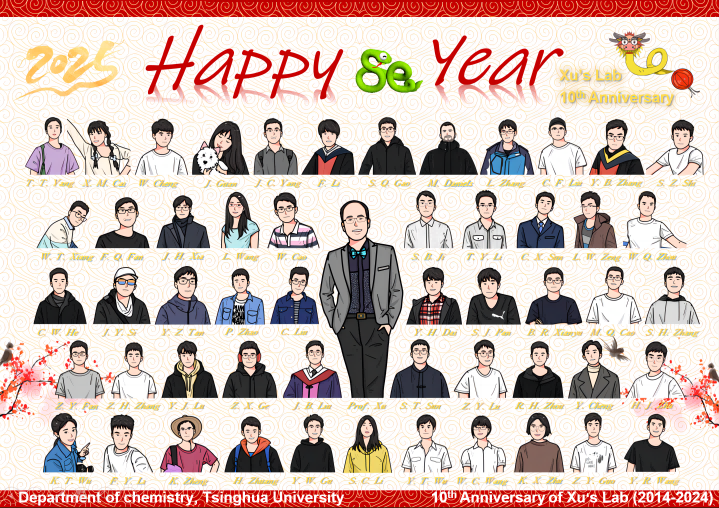
Author: wanglu
Dynamic Diselenide Hydrogels for Controlled Tumor Organoid Culture and Dendritic Cell Vaccination
Yueying Han, Cheng Liu, Sheng Yin, Jian Cui, Yang Sun, Bin Xue, Chunping Jiang, Xiaosong Gu, Meng Qin, Wei Wang, Huaping Xu*, Yi Cao*.
ACS Appl. Mater. Interfaces, 2024, 16, 69114.
Dynamic hydrogels are emerging as advanced materials for engineering tissue-like environments that mimic cellular microenvironments. We introduce a diselenide-cross-linked hydrogel system with light-responsive properties, designed for precise control of tumor organoid growth and light-initiated radical inactivation, particularly for dendritic cell (DC) vaccines. Diselenide exchange enables stress relaxation and hy...
More
Prof. Maria Vamvakaki visited Tsinghua University and gave a lecture
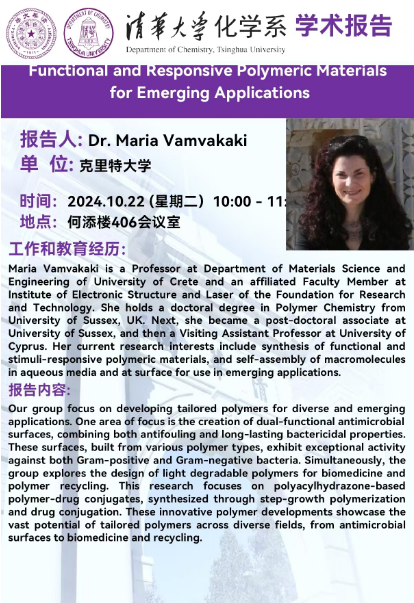
On October 22th, 2024, Prof. Maria Vamvakaki from the University of Crete visited Tsinghua University and delivered a lecture on her research.
Prof. Maria Vamvakaki is a professor at Department of Materials Science and Engineering of University of Crete and an affiliated Faculty Member at Institute of Electronic Structure and Laser of the Foundation for Research and Technology. She holds a doctoral degree in Polymer Chemistry from University of Sussex, UK. Next, she became a post-doctoral associate at University of Sussex, and then a Visiting Assistant Professor at University of Cyprus. Her c...
More
Mini Symposium on Dynamic Polymers
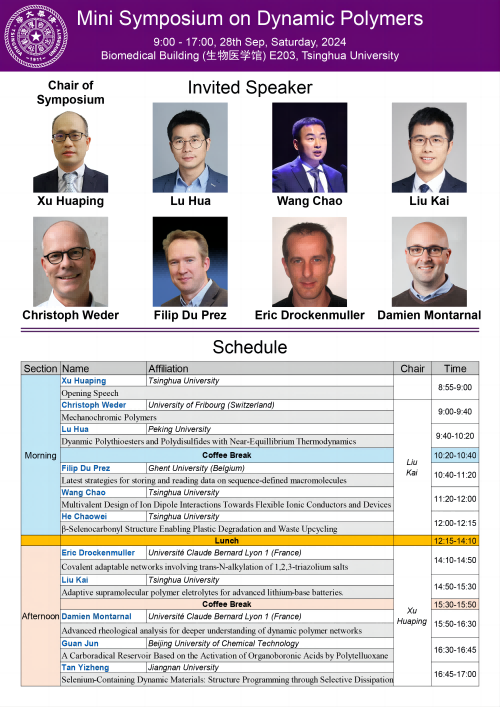
On 28th Sep, our group organized a mini symposium on dynamic polymers at Biomedical Building E203 in Tsinghua University, with many famous professors invited. The content of the symposium is as follows:
The discuss atmosphere of the symposium was very hot, the professors and students exchanged their minds passionately. More photos can be seen in GALLERY.
More
Assembly Regulates Gamma Radiation Polymerization of Polytelluoxane
Shenghan Zhang, Yijie Lu, Junjie Song, Jun Guan, Yiheng Dai, Wei Cao*, and Huaping Xu*
Angew. Chem. Int. Ed.; 2025, e202415811
Regulating chemical drug's responsiveness to gamma radiation is crucial for achieving better therapeutic effects in cancer treatment. Most research focused on thermodynamic chemical structure design, while little attention was paid to kinetic regulate strategy, which possesses greater universality and security. In this study, we achieved a kinetic-based regulate strategy of gamma radiation reaction, through the construction of microphase environment during polymeri...
More
Intracellular Construction of Topological Polymer Networks to Destruct Organelles
Chengfei Liu, Banruo Xianyu, Chaowei He, Muqing Cao, Zhuolin Chen, Tianyu Li and Huaping Xu*
CCS Chem.; 2025, 403-415
Topological polymers play a major role in their interaction with intracellular organelles to affect their cellular activities owing to their large surface area and multilevel branched structures. Yet, the existing studies on these polymers mainly focus on the topochemical polymerization outside the cells and how these topological polymers interact with the cell outer membrane. Herein, we established an intracellular topological polymerization based on the 2′-Te modified o...
More
S-Se-S type molecule: A bactericidal promoter against H2S-induced antibiotic resistance
Mengnan Liu1, Fanqiang Bu1, Guofeng Li, Wensheng Xie, Huaping Xu*, Xing Wang*
The Innovation Life.; 2024, 2, 100076
The hydrogen sulfide (H2S)-induced defense system is a crucial bacterial pathway that leads to antibiotic resistance. Herein, a unique S-Se-S molecule, namely, 2,2’-(selenobis(sulfanediyl))diacetic acid (Se-Acid), is first reported to relieve H2S-induced antibiotic resistance by acting as a hydrogen selenide (H2Se) donor. The S-Se-S molecular structure was formed using the carboxyl terminal as an electron acceptor. After being endocytosed by cells, Se-Acid effectively released ...
More
Gradually Self-Strengthen DNA Supramolecular Hydrogels
Xiuji Du, Yongzheng Xing, Yujie Li, Muqing Cao, Jun Wu, Guizhi Dong, Ziwei Shi, Xunan Wei, Miaomiao Qiu, Junjie Gao, Yun Xu, Huaping Xu, Dongsheng Liu, Yuanchen Dong*
Macromol. Rapid Commun.; 2024, 45, 2400177
The dynamic mechanical strength of the extracellular matrix (ECM) has been demonstrated to play important role in determining the cell behavior. Growing evidences suggest that the gradual stiffening process of the matrix is particularly decisive during tissue development and wound healing. Herein, a novel strategy to prepare hydrogels with gradually enhanced mechanical strength is prov...
More
Prof. Huaping Xu served for Executive Editor of ACS Applied Materials & Interfaces
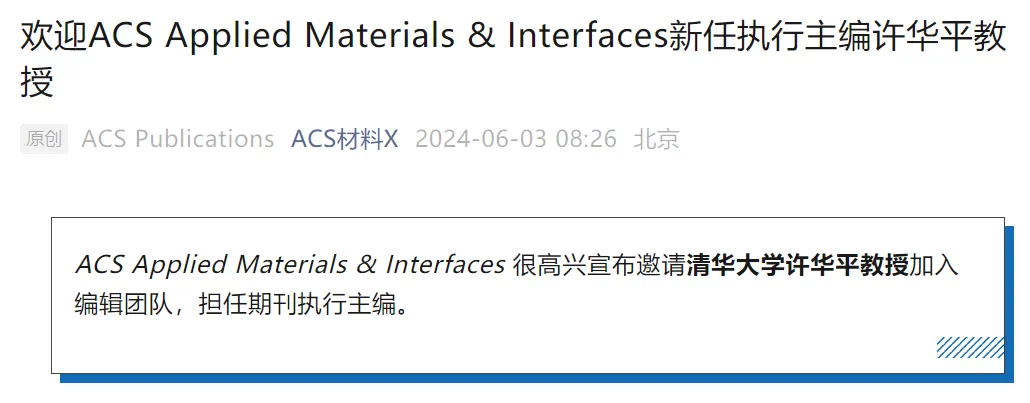
Prof. Huaping Xu served for Executive Editor of ACS Applied Materials & Interfaces since June 2024.
ACS Applied Materials & Interfaces serves the interdisciplinary community of chemists, engineers, physicists and biologists focusing on how newly-discovered materials and interfacial processes can be developed and used for specific applications. The editors are proud of the rapid growth of the journal since its inception in 2009, both in terms of the number of published articles and the impact of the research reported in those articles. ACS AMI is also truly international, with the majo...
More
Dynamic covalent bond-based materials: From construction to biomedical applications
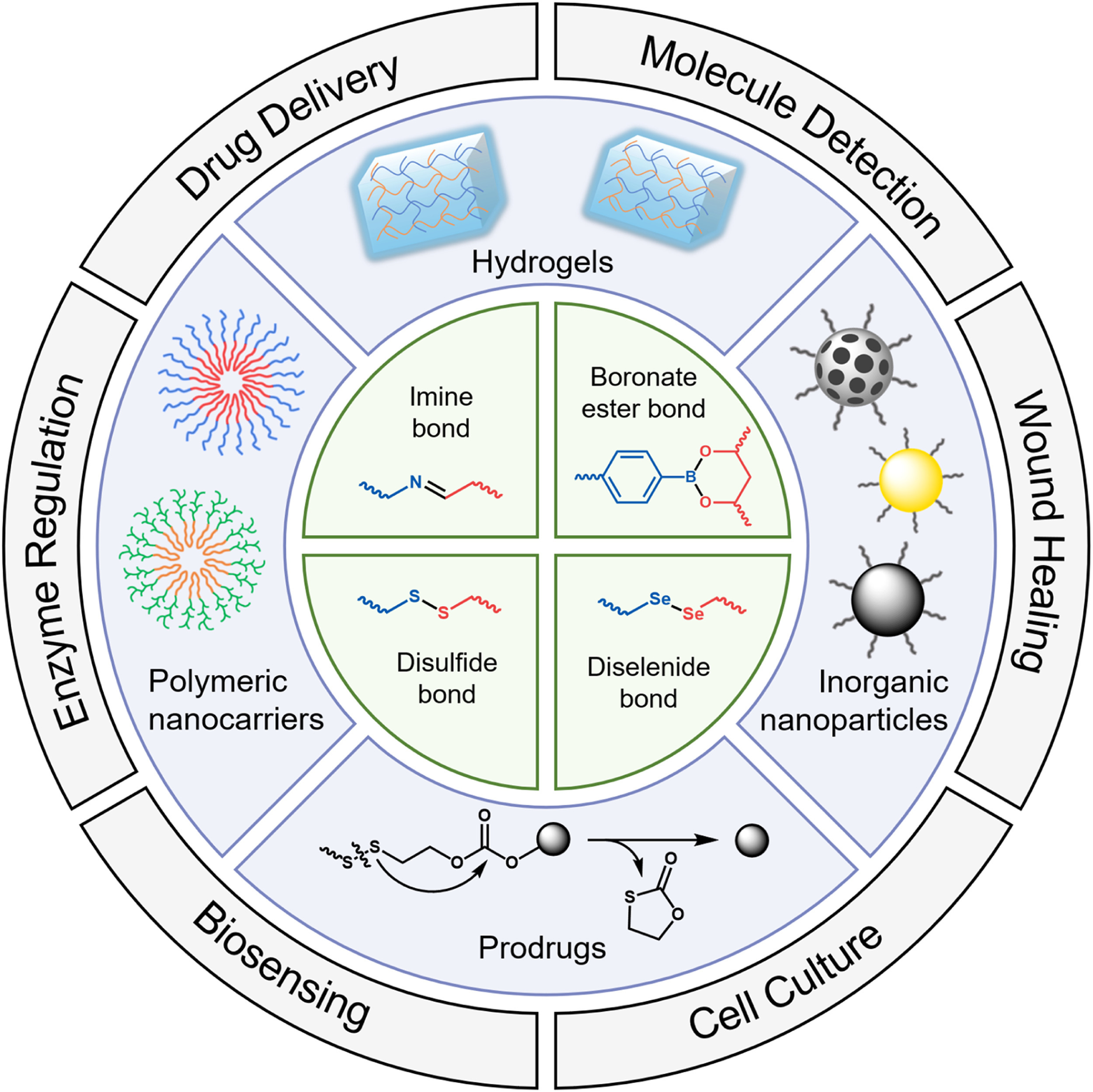
Banruo Xianyu and Huaping Xu*
Supramolecular Materials; 2024, 3, 100070
Dynamic covalent bonds (DCBs) have received significant interest due to their unique reversibility and stimuli-responsiveness. The introduction of DCBs provides materials with self-healing and controllable load and release properties, which result in the emergence of widespread applications in biomedical disciplines. In this minireview, we first introduce the chemistry nature and reaction characteristics of different types of DCBs followed by discussing the design strategies of DCB materials. Finally, we summarize the la...
More
